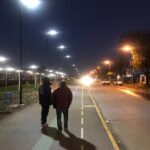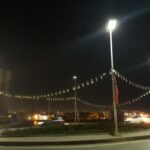Science plays a significant role in solar powered street lights design. The features that come with the solar units rely on Chemistry and physics concepts. Therefore, every component that makes up the system carries some scientific touch in it.
Most solar street light users are only familiar with visible technologies and innovations, but there is something more unique and complex that lies beneath the features and special functions we see.
Lets now look at the scientific evidence in each of the components in a solar street light system.

Science Behind Solar Panels
Solar panels or photovoltaic cells, they all mean the same thing. These cells are semi-conductive materials, such as silicon, which rely on the photovoltaic effect to generate and conduct Direct Current. This effect gets a boost from the electric field formed by the positively (p-type) and negatively (n-type) charged cells.
When sunlight falls on the PV cell, invisible particles, also known as Photons, will displace an electron making it free. The electric field created by the layers of negatively and positively charged semiconductor moves the free carriers forming an energy current. The photovoltaic effect generates direct current (DC) electricity that needs to be stored in the battery to be used later at night.
To understand the science in solar panels, picture this: A semiconductor material absorbs photons from the sun rays that excite the electrons in the material which decide to travel through the cell unit. An electrode is fixed at the end to capture the traveling electrons, and that is how we create electricity. The layers of charged semiconductor material create an electric field that drives the charged particles to form a direct current flow.
Since the discovery and demonstration of the photovoltaic effect, there have been improvements in the PV cells. This advancement in science has produced two types of PV cells, Monocrystalline, and Poly or multi-crystalline panels.
Science of Charge Controllers
Standing between the PV panel and the battery, the charge controllers protect the battery from overcharging, overheating, and over-discharging. When the unit reaches the set maximum and minimum voltage level, the controller will regulate the charging and discharging process through short-circuiting and switching methods.
An electrical knowledge, especially that of open circuiting, will help you understand the operations of charge controllers.
The Science Behind Solar Batteries.
The battery is the storage equipment in a solar street light system. There is enough science in the form of chemistry and physics that goes on this component. With the right rechargeable battery, you get the advantage of a smooth supply of electricity at night.
There are many different types of rechargeable batteries you can use in your solar-powered streetlight system, including Lithium-Ion, Lead-Acid Batteries, Gel Deep Cycle Sodium-Sulfur, Metal Air, and flow battery.
The science behind these batteries is in charging an enclosed conductive liquid (electrolyte) separated by cells that connect to a negative or positive polar end. How you charge and drain your battery will determine its lifespan: Overcharging and exhausting your solar batteries reduces the design’s period of service.
Choosing the right battery for your solar powered street lights design requires a deliberative comparison between the chemistry and attributes of various electrolytes. What you need to understand here is the conversion of electrical energy into chemical energy.
The Science Behind the Inverter
The type of electricity that powers our buildings and solar Luminaires is alternating current (AC) current, but we all know that the PV cell can only generate direct current (DC) electricity. Science has made it easy for us to convert High voltage DC to AC using an inverter.
The inverter you choose may use apparatus that are electronic, mechanical, or a combination of both. In case of very low currents and voltages, you will need oscillators and not an inverter. You will need an inverter if your photovoltaic solar panels produce a power compacity of 200 to 400 V DC.
The science of inverter is all about waveforms (sine wave, modified sine wave, or square wave) depending on the circuit solar powered street lights design. The science behind the operation of inverters ensures that the output frequency, voltage, and power is the same as the standard required. For solar applications, you can use an inverter in both off-grid and grid-connected systems.
The use of electromagnetic devices(switches), capacitors, and inductors enables the conversion of DC to AC. In most integrated modules, you will find a micro-inverter in use in the transformation of convert DC to AC.
Solar powered street lights design
Science in Solar LED Lamps
Without electrical, optical and thermal knowledge, it would be hard for you to understand the science behind LED bulbs. All these fields have to be coordinated to come up with an efficient and energy-saving light source. The lighting fixture is just a circuitry where, in the end, electrical energy is converted to light energy by the use of light-emitting diodes.
Different from the solar panel, the combination of excited electrons in the semiconductor and the electron holes releases photons. Therefore, you will need to familiarize yourself with semiconductors, electrons, and holes to understand the science behind LED lamps.
Science in Solar Poles
The primary scientific knowledge useful in the solar powered street lights design poles is material science. This field looks into the physical, mechanical, and chemical characteristics of a combination of materials to develop wind resistance. Metals alloying and cast-dying are two of the most used scientific techniques.
Material science is also applicable in the design of housings of coverings for the various components of a solar street light system. The science here is responsible for waterproof and dustproof qualities in the lighting fixture.
Solar powered street lights design
Solar Powered Street Lights Design: Conclusion
Understanding the science behind solar-powered street lights design will help in the selection of efficient and energy-saving technology for the system. To find out how these systems work, you’ll need to understand how they are made. Furthermore, new scientific innovations will enable you to pick state-of-the-art components.
DEL ILLUMINATION is deeply rooted in science, the foundation and pillar of our efficient and energy-saving solar street light system designs.
Check out our article on Achieving More Hours of a Solar Street Light at Night.


















